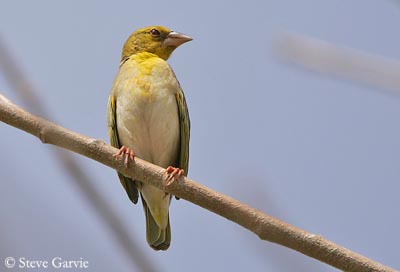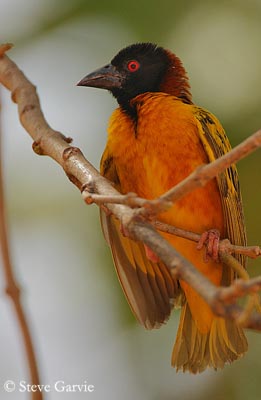
Village Weaver
Ploceus cucullatus
Passeriforme Order – Ploceidae Family
BIOMETRICS :
Length : 15-18 cm
Weight : 32-45 g
DESCRIPTION:
Village Weaver is a large heavy-billed weaver.
Village Weaver name derives from their usual habits of nesting near villages in Africa, probably for protection.
However, introduced birds to Caribbean and Indian Ocean become invasive and are a threat to native bird species. It is the most damaging agricultural pest in Mauritius and Haiti. Several kinds of controls have been tried and unsuccessful. Challenge is to find a way to make peaceful the coexistence between humans and birds, despite the threat that village Weavers are for agriculture.
Fr: Tisserin gendarme
All : Textor
Esp : Tejedor de la Villa
Ital : Tessitore testanera dei villaggi
Nd : Grote Textorwever
Russe : Черноголовый ткач
Photographers :
Steve Garvie
RAINBIRDER Photo galleries
Callie de Wet
GALLERY
Text by Nicole Bouglouan
Sources :
BIRDS OF AFRICA SOUTH OF THE SAHARA by Ian Sinclair and Peter Ryan - Princeton University Press Princeton and Oxford - ISBN: 0691118159
L’ENCYCLOPEDIE MONDIALE DES OISEAUX - Dr Christopher M. Perrins - BORDAS - ISBN: 2040185607
Wikipedia (Wikipedia, The Free Encyclopedia)
BirdLife International (BirdLife International)
Birds of Southern Africa (Tony Roocroft)

Female and non breeding male have olive-grey-green crown. Back is grey-brown, but variable, and we can see darker streaks on central feathers. Underparts are yellow, but some individuals have greyish belly. Wings remain yellow and black.
Both have prominent yellow supercilium. Eyes are reddish. Strong bill is fleshy-horn coloured.
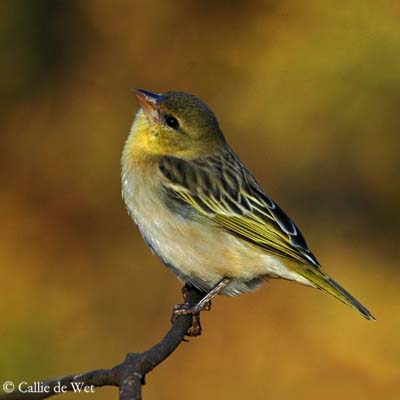
Juvenile resembles female, with browner back.
We can find seven subspecies, and among them:
Ploceus cucullatus collaris, from Zaire and Northern Angola
Ploceus cucullatus spilonatus, from South Africa.
They differ by dark back pattern and underparts’ colours.
VOICE: SOUNDS BY XENO-CANTO
Village Weaver is very noisy at colonies. It produces a streaming chatter in a jumble of short, harsh notes drawing out to buzzy phrases, before ending in a babble of harder sounds.
Flight call is “cluck”, and we can hear throaty “chuck-chuck”.
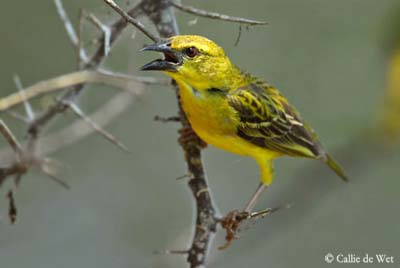
HABITAT:
Village Weaver lives in open habitats such as savannahs, fields and gardens, open woodlands and human habitation. It may form noisy colonies in towns. This species needs large trees for nesting, such as palms, and may also nest in reedbeds along rivers and streams. It is absent from arid habitats.
RANGE:
Village Weaver is resident in Sub-Saharan Africa, and this species has been introduced to Haiti, Dominican Republic, Puerto Rico, Mauritius and Reunion.
BEHAVIOUR:
Village Weavers are gregarious birds. They forage and roost in large flocks with other weavers’ species. They may perform some regular movements in some areas.
Village Weaver forages on the ground, and gleans on vegetation and trees. It is considered as a pest of seed crops, although it consumes large numbers of insects. It also tears strips from oil palms leaves, only leaving the central stem.
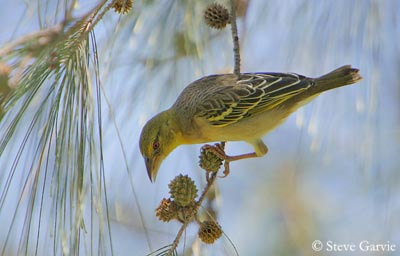
They nest in colonies, very active in breeding season. Birds perform heavy traffic coming and going, producing much noise. Numerous nests may hang from one tree, and colonies of up to 70 to 150 nests may be found, but usually, colonies include from 8 to 100 nests, according to the tree size.
Male displays when nest is built. It hangs from the nest base, upside down, and with fluttering wings, while it is calling. Breeding season varies according to the place, but is Central Africa, it continues throughout the year.
Village Weaver is, at first, monogamous, becoming polygamous later. Male begins breeding season with one female, and it may find other female to mate with. After the first nest is built and first female incubates, male builds another nest and tries to attract another female. One male may have up to five mates in five nests. Each male displays its last nest with an individual distinctive call.
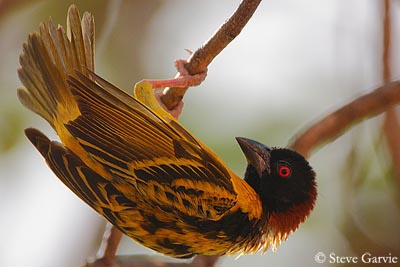
Village Weaver’s nests are frequently parasitized by Diderick Cuckoo. But however, the female host may spot the intruder’s egg and eject it from the nest. Continuous changing egg colours can also confuse Diderick Cuckoo.
Village Weaver is known for its adaptation to new environments, often much different from the original for introduced birds.
FLIGHT:
Village Weaver moves in swift flocks with light, shallow, bounding flight action.
REPRODUCTION:
Village Weaver’s nest is often suspended from a tree branch low over fresh water. This species favours large trees, and may also occupy several adjacent trees. Village Weaver male builds the nest. This one is rounded, slightly “onion-shaped”, with short downwards extension at base to entrance.
Nest is coarsely woven by male, with grasses, strips of plantain or oil palm leaf. Village Weavers form larger colonies than other species, and numerous nests may be placed very close to each other. Sometimes, nests may be interwoven together.
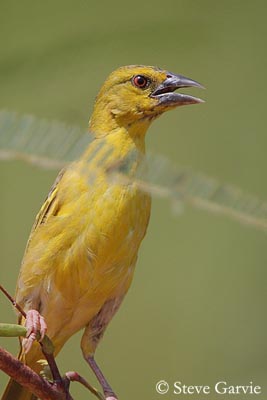
Female lays 2 to 3 eggs. Colours can change according to each female. Incubation lasts about 14 days, by female alone. Young fledge about 11 to 20 days after hatching.
The length of rainy season determines the length of breeding season.
DIET:
Village Weaver feeds on seeds, fresh vegetation, fruit, ant eggs and mealworms. It feeds on rice when available. It also eats ripe cacti fruits in Caribbean, providing water source to the bird.
PROTECTION / THREATS / STATUS:
Village Weaver populations are common and widespread in their range. This species is very adaptable and not threatened.
